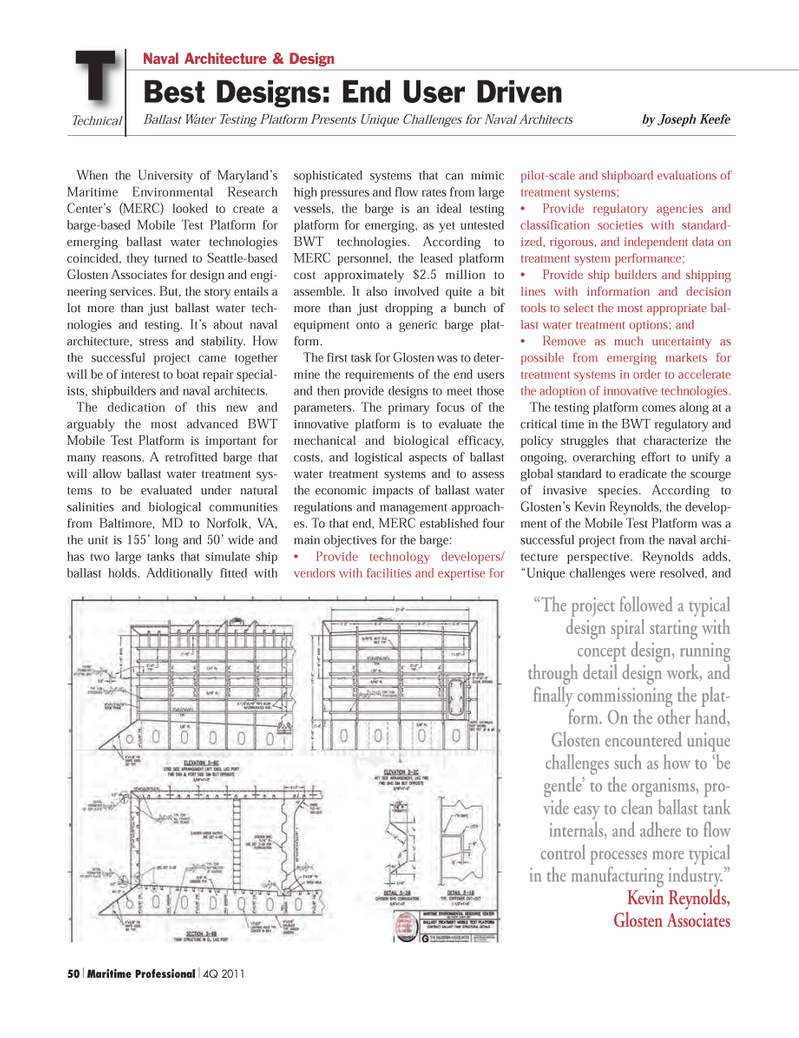
Page 50: of Maritime Logistics Professional Magazine (Q4 2011)
Classification
Read this page in Pdf, Flash or Html5 edition of Q4 2011 Maritime Logistics Professional Magazine
50 Maritime Professional 4Q 2011TTechnical Best Designs: End User DrivenBallast Water Testing Platform Presents Unique Challenges for Naval Architects by Joseph Keefe Naval Architecture & Design When the University of Maryland?s Maritime Environmental Research Center?s (MERC) looked to create a barge-based Mobile Test Platform for emerging ballast water technologies coincided, they turned to Seattle-based Glosten Associates for design and engi- neering services. But, the story entails alot more than just ballast water tech- nologies and testing. It?s about naval architecture, stress and stability. How the successful project came togetherwill be of interest to boat repair special-ists, shipbuilders and naval architects. The dedication of this new and arguably the most advanced BWT Mobile Test Platform is important for many reasons. A retrofitted barge that will allow ballast water treatment sys- tems to be evaluated under natural salinities and biological communitiesfrom Baltimore, MD to Norfolk, VA, the unit is 155? long and 50? wide and has two large tanks that simulate ship ballast holds. Additionally fitted with sophisticated systems that can mimichigh pressures and flow rates from large vessels, the barge is an ideal testing platform for emerging, as yet untested BWT technologies. According to MERC personnel, the leased platformcost approximately $2.5 million toassemble. It also involved quite a bit more than just dropping a bunch of equipment onto a generic barge plat- form.The first task for Glosten was to deter- mine the requirements of the end usersand then provide designs to meet those parameters. The primary focus of the innovative platform is to evaluate the mechanical and biological efficacy, costs, and logistical aspects of ballastwater treatment systems and to assess the economic impacts of ballast water regulations and management approach- es. To that end, MERC established four main objectives for the barge: Provide technology developers/ vendors with facilities and expertise for pilot-scale and shipboard evaluations of treatment systems;Provide regulatory agencies and classification societies with standard- ized, rigorous, and independent data ontreatment system performance; Provide ship builders and shipping lines with information and decisiontools to select the most appropriate bal-last water treatment options; and Remove as much uncertainty as possible from emerging markets for treatment systems in order to acceleratethe adoption of innovative technologies. The testing platform comes along at acritical time in the BWT regulatory andpolicy struggles that characterize the ongoing, overarching effort to unify a global standard to eradicate the scourge of invasive species. According to Glosten?s Kevin Reynolds, the develop- ment of the Mobile Test Platform was a successful project from the naval archi- tecture perspective. Reynolds adds, ?Unique challenges were resolved, and ?The project followed a typical design spiral starting with concept design, running through detail design work, and finally commissioning the plat-form. On the other hand, Glosten encountered unique challenges such as how to ?be gentle? to the organisms, pro- vide easy to clean ballast tankinternals, and adhere to flow control processes more typical in the manufacturing industry.? Kevin Reynolds, Glosten Associates MP #4 (50-64):MP Layouts 11/8/2011 2:27 PM Page 50

 49
49

 51
51
